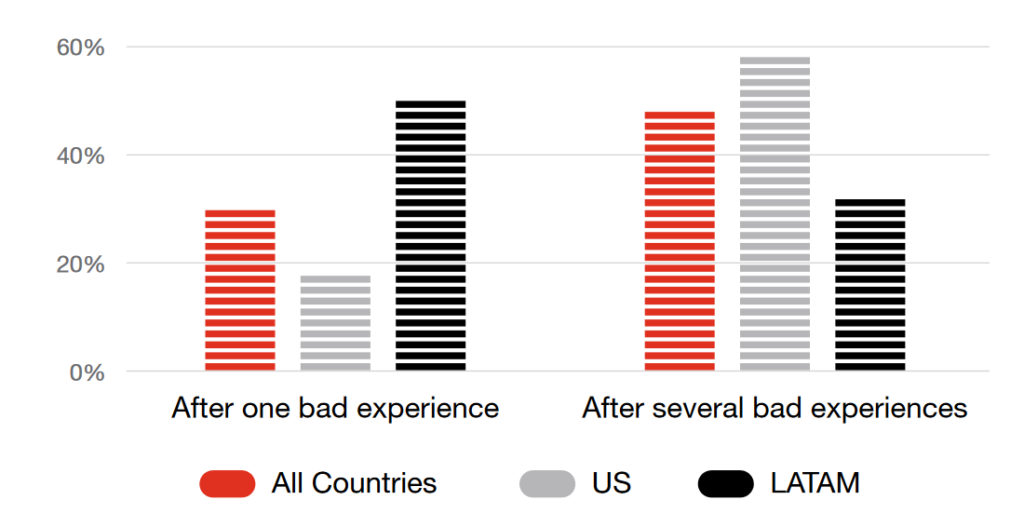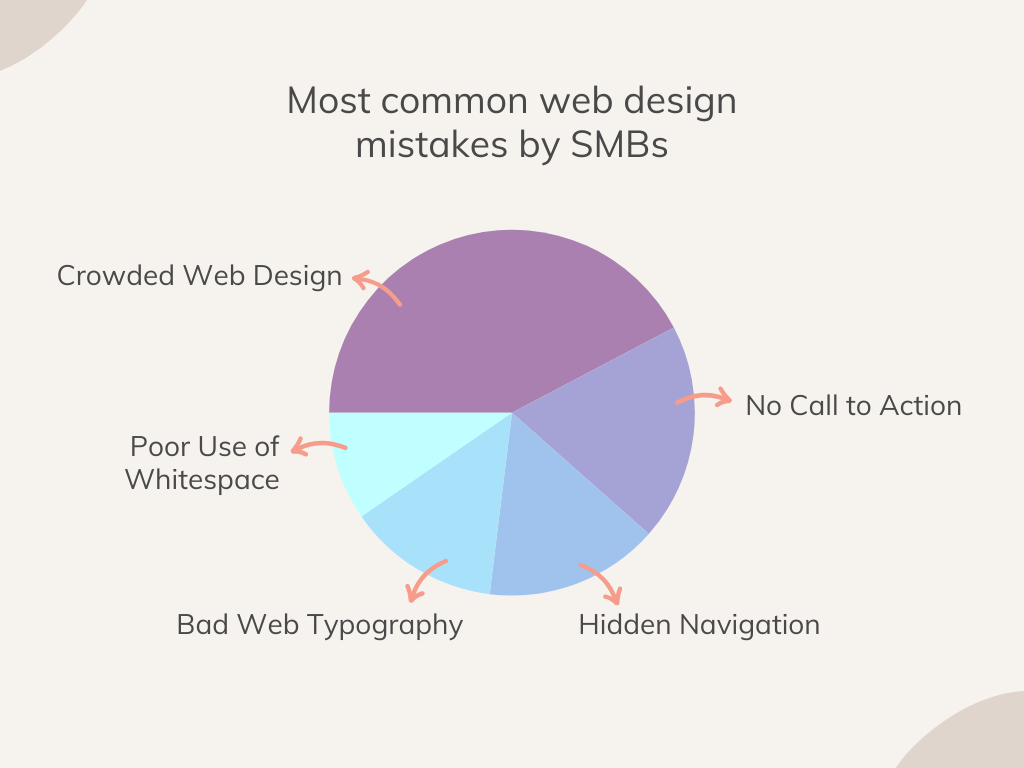
30+ Most Important UX Statistics to Know for 2024
Have you ever wondered how we sometimes get hooked on some websites and end up spending hours without even noticing it? Or why it becomes effortless to navigate some sites while others are downright frustrating, making it a chore to find what you’re looking for?
So, what exactly sets these websites or products apart?
The answer to these questions lies in better User Experience design. User Experience (UX) assesses the consumer’s feelings while visiting a website. It is paramount as it directly influences user satisfaction, engagement, and loyalty, ultimately impacting conversions, cost-effectiveness, competitiveness, brand reputation, and accessibility.
Here is why running a website without good user experience design is like serving a meal without utensils. It might get the job done but won’t leave a lasting impression.
10 Key trends in UX design
Evolution is constant in the field of UX design. Hence, maintaining a curiosity about the latest UX best practices not only aids newcomers in understanding what to expect in the field but also assists experienced UX designers in implementing cutting-edge work strategies.
- Personalised user experience is on everyone’s mind
- Data visualisation to convey complex information effectively
- Incorporation of 3D designs has been a growing trend
- Dark mode option for improved user experience
- The adoption of responsive design is a popular design choice
- Voice user interfaces have also gained significant importance
- AI integration plays a pivotal role
- Another latest trend is typography
- Demand for accessible design remains strong
30+ UX statistics you need to know
1. 88% of people are less inclined to return to a site after a bad UX
This statistic indicates that the majority of users, 88%, are significantly deterred from revisiting a website if they have a negative user experience (UX). Poor UX can include slow loading times, confusing navigation, or unresponsive design, all of which frustrate users and diminish their desire to return.
As user experience becomes increasingly pivotal in online interactions, businesses must prioritise optimising their websites to ensure positive experiences and retain their audience. (Source)
2. 90% of users have stopped using an app due to poor performance
The statistic indicating that 90% of users have stopped using an app due to poor performance underscores the critical importance of user experience in the digital landscape. In today’s fast-paced world, users expect seamless performance from their applications.
Poor performance can manifest in various forms, including slow loading times, frequent crashes, or unresponsive interfaces, which can severely disrupt user workflow and diminish the app’s perceived value. As such, mobile app developers must prioritise optimising app performance to retain users and foster positive experiences. (Source)
3. Judgments on website credibility are 75% based on a website’s overall aesthetics
The fact that 75% of judgments about website trust depend on how it looks shows how important it is for a website to look good. This includes how it’s laid out, what colours and fonts are used, and if everything fits together well.
People are more likely to trust a website that looks good and seems professional. This means it’s really important to spend time and effort making a website look nice and easy to use. Basically, how a website looks is key to making people trust it and want to use it. (Source)
4. Every $1 invested in UX design yields a return of $100 (ROI = 9,900%)
For every $1 invested in UX design, the return is a staggering $100, translating to an ROI of 9,900%. This emphasises UX’s critical role in driving business success and revenue generation. Investing in UX design enhances user satisfaction and leads to increased customer retention, higher conversion rates, and improved brand perception.
It underscores the value of prioritising user-centric design practices across all stages of product development. (Source)
5. 32% of customers would leave a brand they loved after just one bad experience
This statistic suggests that customer loyalty is fragile, with a substantial portion of customers willing to abandon a beloved brand due to a single negative encounter. It underscores the critical importance for businesses to consistently provide exceptional customer experiences to maintain loyalty and prevent attrition.
Even a minor misstep can have significant repercussions, highlighting the need for businesses to prioritise customer satisfaction and service excellence. (Source)

6. 57% of shoppers will abandon if they have to wait three seconds for a page to load
With 57% of shoppers indicating they will abandon a webpage if it takes three seconds or longer to load, the implications for businesses are significant. This statistic underscores online consumers’ inherent impatience and expectations for near-instantaneous access to information and services.
In a world where attention spans are shrinking, and alternatives are abundant, even a slight delay in page loading can result in potential customers abandoning a website in favour of faster alternatives. (Source)
7. 74% of people are more likely to return to a mobile-friendly site, and 67% are more likely to buy a product or service from such a site
As mobile devices increasingly dominate online access, ensuring that websites are optimised for mobile viewing is no longer a luxury but a necessity. Mobile-friendly sites enhance the user experience by providing seamless navigation and readability across various devices and instilling confidence and trust in potential customers.
By prioritising mobile-friendliness, businesses can tap into a significant portion of the market and capitalise on the growing trend of mobile commerce, ultimately boosting customer retention and driving revenue growth. (Source)
8. A substantial 94% of initial impressions about a website directly result from its design
When users land on a website, they make immediate judgments based on its design aesthetics, layout, and functionality. A visually pleasing and intuitively navigable design can captivate visitors, encouraging them to explore and engage with the content.
Conversely, a poorly designed website can deter users within seconds, leading to high bounce rates and lost opportunities. This statistic highlights the critical role of design in establishing credibility, trust, and user satisfaction, ultimately shaping users’ perceptions and interactions with the brand. (Source)
9. A significant 70% of companies view UX and customer experience (CX) as crucial factors distinguishing them from competitors
The discovery that 70% of businesses view user experience (UX) and customer experience (CX) as crucial differentiators highlights the growing recognition of their significant role in competitive markets. In today’s saturated digital arena, where products and services often boast similar features, the quality of user experience becomes a vital battleground for brands striving to stand out.
By prioritising UX and CX, companies can nurture meaningful connections with their customers, fostering loyalty, advocacy, and sustained success. (Source)
10. Following a poor user experience, up to 89% of people have switched to a competitor’s website
In today’s highly competitive digital landscape, consumers have numerous options at their fingertips. When they encounter difficulties navigating a website, encountering slow loading times, or experiencing other frustrations, they quickly seek alternatives.
This behaviour highlights users’ low tolerance for subpar experiences and emphasises the direct link between UX and customer loyalty. (Source)
11. 70% of users abandon shopping carts due to poor UX
Shopping cart abandonment is a significant challenge for online retailers, directly impacting revenue and conversion rates. Factors contributing to poor UX in ecommerce, such as a cumbersome checkout process, unexpected fees, or confusing navigation, can deter users from completing their purchases.
This statistic underscores the importance of optimising every aspect of the online shopping journey to reduce friction and increase the likelihood of conversion. (Source)
12. 67% of enterprises polled stated Voice Interface is the most important trend affecting UX in the next 5 years
With 67% of enterprises acknowledging this trend, it reflects a significant shift in how users interact with technology. Voice interfaces, driven by advancements in natural language processing and voice recognition technology, offer a more intuitive and hands-free way for users to engage with devices and services.
This trend suggests that businesses must prioritise integrating voice interface capabilities into their products and services to meet evolving user expectations. (Source)
13. According to 84.6% of website designers, a crowded page design is the most common mistake made by small businesses
The statistic, which highlights that 84.6% of website designers identify crowded page design as the most common mistake small businesses make, underscores the importance of clean and organised web layouts.
A crowded page can overwhelm visitors, making navigating, finding information difficult, and engaging with the website difficult. It often results in a cluttered visual experience that can deter potential customers and diminish the site’s effectiveness. (Source)

14. 70% of online businesses fall through because of bad UX
Bad UX can encompass various factors, including confusing navigation, slow loading times, lack of responsiveness, and unintuitive interfaces. Such shortcomings frustrate users, leading to high bounce rates, low engagement, and loss of potential customers.
This statistic underscores the critical need for businesses to prioritise UX optimisation to create seamless and enjoyable user experiences, thereby reducing the risk of failure and increasing the likelihood of long-term success in the highly competitive online landscape. (Source)
15. If they have a bad experience, 13% of customers will tell at least 15 people about it
The fact that 13% of customers will tell at least 15 people about a bad experience underscores the ripple effect of negative encounters. Word-of-mouth communication remains a potent force in shaping public opinion and can significantly influence others’ perceptions of a brand or business.
Each dissatisfied customer who shares their experience with a large number of people amplifies the potential damage to the reputation and credibility of the company, potentially deterring others from engaging with it. (Source)
16. 91% of unsatisfied customers don’t complain about their bad experience- they leave without giving feedback
The fact that 91% of dissatisfied customers choose not to voice their concerns but instead silently disengage from the business highlights a significant challenge in customer service management: understanding and addressing hidden dissatisfaction. This silent majority represents a missed opportunity for businesses to resolve issues, enhance their services, and retain valuable customers.
Without effective feedback channels and mechanisms for capturing customer sentiments, companies risk losing important insights into areas needing improvement, ultimately jeopardising their competitiveness in the market. (Source)
17. Nearly half, or 46.1%, of companies acknowledge that UX design plays a role in influencing web design costs
This statistic reveals that nearly half of companies, at 46.1%, recognise the impact of UX design on web design costs. This indicates a growing understanding of the importance of user experience (UX) in shaping a website’s overall design and functionality.
Investing in UX design can lead to more intuitive interfaces, smoother navigation, and, ultimately, higher user satisfaction. (Source)
18. 86% of buyers will pay more for a great customer experience
This statistic emphasises the significant role that customer experience (CX) plays in consumer behaviour, with 86% of buyers willing to pay more for a great customer experience. This highlights the power of positive interactions and seamless transactions in shaping customer perceptions and influencing purchasing decisions.
Businesses prioritising delivering exceptional customer experiences across all touchpoints, including their website, can differentiate themselves from competitors and foster long-term customer relationships. (Source)
19. 70% of consumers across all platforms choose to use dark mode settings
The widespread adoption of dark mode settings by 70% of consumers across various platforms can be attributed to several factors. As its popularity continues to rise, the dark mode has evolved from a mere novelty to a fundamental feature embraced by designers and users alike, shaping the digital design landscape for years to come. (Source)
20. 38% of people will stop engaging with a website if the content or layout is unattractive
The statistic stating that 38% of people will disengage from a website if its content or layout is unattractive highlights the significance of first impressions in online interactions. When users encounter an unattractive or poorly laid out website, they are more likely to navigate away in search of a more visually appealing and intuitive alternative.
This underscores the importance of investing in professional web design and content creation to capture and maintain users’ attention. (Source)
21. 67% of users say that a poor website experience negatively affects their opinion of a brand
This statistic emphasises the direct correlation between website quality and brand perception. In today’s interconnected world, a brand’s online presence is a significant touchpoint for consumer interaction and brand evaluation. A usual website experience drives users away in the short term and tarnishes their perception of the brand in the long run.
Negative experiences can lead to diminished trust, credibility, and loyalty, potentially resulting in lost customer acquisition and retention opportunities. (Source)
22. Approximately $2.6 billion in annual revenue is forfeited due to sluggish website loading times
Studies have consistently shown that even minor delays in page loading times can lead to increased bounce rates, where visitors abandon a website before it fully loads. This loss of revenue reflects not only direct transactions but also the potential for diminished customer engagement, reduced brand loyalty, and missed opportunities for conversions.
Businesses must prioritise optimising their websites for speed and efficiency to remain competitive in an environment where user experience plays a pivotal role in driving online success. (Source)
23. 94% of people won’t trust an outdated website
The statistic indicating that 94% of people won’t trust an outdated website highlights the importance of maintaining a modern and relevant online presence. An outdated website may convey the impression that a business is neglectful or behind the times, undermining trust and confidence in its products or services.
Furthermore, an outdated website may also raise concerns about security vulnerabilities or outdated information, further eroding trust among potential customers. (Source)
24. 75% of sites that use an image carousel design on the homepage don’t implement it correctly
This statistic highlights a common issue in web design and user experience. Image carousels, also known as sliders, are popular features used to showcase multiple images or messages in a rotating manner. However, they often suffer from usability and accessibility problems.
Many websites misuse carousels by cramming too much content into them, leading to slow loading times and overwhelming visitors with information. (Source)
25. 63.64% of the surveyed used a chatbot to buy a product online
The statistic sheds light on the growing trend of conversational commerce. Powered by artificial intelligence, chatbots provide a convenient and interactive way for users to engage with businesses and complete transactions.
By integrating chatbots into their online platforms, companies can offer personalised assistance, answer customer queries, and guide users through the purchasing process in real-time. (Source)
26. More than half, or 54%, of marketing experts identify ad clutter as the primary hindrance to a positive user experience
More than half of marketing experts, specifically 54%, pinpoint ad clutter as the foremost obstacle to crafting a positive user experience. This statistic underscores advertisers’ pervasive challenge in navigating the digital landscape, where consumers are bombarded with an overwhelming volume of advertisements.
Ad clutter disrupts the flow of content and detracts from the overall user experience, potentially leading to frustration and disengagement. (Source)
27. Only 55% of companies conduct UX testing
This statistic highlights a significant gap in prioritising user experience (UX) within businesses. Despite the widespread acknowledgment of its importance in product development, a substantial portion of companies are still not actively engaging in UX testing.
This could be attributed to various factors, including limited resources, a lack of understanding of the benefits of UX testing, or a focus on other aspects of product development. (Source)
28. 51% of enterprises polled saw an increase of 25% in their UX research budget
This increase suggests that more companies acknowledge the importance of investing in UX research to create products and services that resonate with their target audience. Such a substantial boost in budget allocation indicates a shifting mindset within enterprises towards prioritising user-centric design approaches. (Source)
29. If a business lacks a website, it risks losing as much as 80% of potential customers
The statistic suggests that without a website, a business could miss out on a significant portion of its potential customer base, with up to 80% of potential customers being lost. In today’s digital age, consumers often turn to the internet as their first port of call when seeking products or services.
Without a website, a business may struggle to establish credibility and visibility, potentially leading to substantial missed opportunities for customer acquisition and revenue generation. (Source)
30. 52% of users are less likely to engage with a company that doesn’t use responsive mobile design
With over half of users indicating that they are less likely to engage with a company that lacks responsive mobile design, businesses must prioritise optimising their websites for mobile devices. As smartphones and tablets continue to dominate internet usage, ensuring a seamless and enjoyable mobile browsing experience has become essential for retaining user engagement and satisfaction. (Source)
31. 85% of users want a mobile experience that’s as good as a desktop
This statistic highlights the increasing demand for mobile experiences that match the quality of desktop browsing. As mobile devices become more powerful and ubiquitous, users expect websites to deliver the same level of functionality and usability across all devices.
This expectation is reflected in the overwhelming majority of users (85%) who desire a mobile experience on par with desktop browsing. Businesses that fail to meet this expectation risk alienating a significant portion of their audience and may struggle to compete effectively in an increasingly mobile-centric market. (Source)
Wrapping up
Investing in a thoughtful UX strategy is about more than keeping users happy—it’s about building trust, loyalty, and lasting relationships with your audience.
To thrive in ecommerce, ensuring that your website is swift, convenient, and user-friendly is essential. By surpassing these expectations, you secure existing customers and attract new ones, gaining an edge over competitors. Every time users interact, whether clicking, swiping, or navigating, they’re on a journey shaped by design, how things work, and how easy it is to use.
References
You read a lot. We like that
Want to take your online business to the next level? Get the tips and insights that matter.

